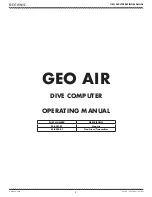
9
Closer to Care.
The analyzer features an internal quality control (iQC
TM
) system that
suppresses values and displays warning or error messages when a problem
occurs. The iQC
TM
conducts several quality and sufficiency checks with
every run while monitoring all technical components of the analyzer.
A suppression or warning does not necessarily mean that your instrument
has a technical fault. It proves that your iQC
TM
is working properly and
ensures that only accurate results will be released.
•
The symbols ~~~ are printed in place of numbers when a result
cannot be determined. The result may be suppressed due to improper
mixing of a reagent bead with diluted sample, a nonlinear reaction, an
endpoint of a particular reaction not reached, a concentration outside
the analyzer’s capabilities or thermal stress. When a chemistry is
suppressed (~~~), the analyzer prints an error report.
•
HEM, LIP, or ICT is printed in place of the analyte concentration if
hemolysis, lipemia or icterus have adversely affected the results.
LIP is also printed if both lipemia and icterus have affected a particular
analyte. HEM is also printed if hemolysis and icterus, hemolysis and
lipemia, or hemolysis, lipemia, and icterus have affected a particular
analyte. Examine the sample indices to determine if more than one
interferent is affecting a particular result.
•
CONFIRM LOW RECOVERIES with an exclamation point (!) next to
every analyte indicates that at least one analyte has a lower concen-
tration than normally expected. If this occurs, re-run the sample —
if the message persists, the sample may be problematic.
•
Warnings and error messages include an internal error code that will
assist the Abaxis Technical Support in diagnosing the issue. Record
the error message and/or print the error report (see chapter 5.2 of the
operator’s manual) before contacting Abaxis Technical Support:
iQC
TM
English
Summary of Contents for Piccolo Xpress AB-801-110-0000
Page 2: ......










































